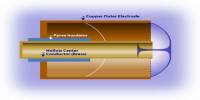Colloidal Gold
A gold colloid is a suspension consisting of sub-micron gold nanoparticles suspended within a solvent, most often water. It is a sol or colloidal suspension of nanoparticles of gold in a fluid, usually water. The colloid is usually either an intense red color (for spherical particles less than 100 nm) or blue/purple (for larger spherical particles or nanorods). It consists of small, microscopic gold particles suspended in distilled water or any other liquid.
The properties of colloidal gold nanoparticles, and thus their potential applications, depend strongly upon their size and shape. They have unique optical, electronic, and thermal properties and are being incorporated in a wide variety of technologies including microscopy, electronics, diagnostics, and therapeutics.
Colloidal gold conjugates with particle sizes of about 100 nm or less cannot sediment because the kinetic energy of the particles is greater than the force of gravity. Gold nanoparticles have unique optical, electronic, and thermal properties and are being incorporated in a wide variety of technologies including microscopy, electronics, diagnostics, and therapeutics.

Due to their optical, electronic, and molecular-recognition properties, gold nanoparticles are the subject of substantial research, with many potential or promised applications in a wide variety of areas, including electron microscopy, electronics, nanotechnology, materials science, and biomedicine. Colloidal gold nanoparticles represent a completely novel technology in the field of particle-based tumor-targeted drug delivery. The tiny gold particles from the colloid penetrate through the cell membranes easily and work effectively towards providing relief from the symptoms of several health issues.
The range of applications for gold nanoparticles is growing rapidly and includes:
- Electronics – Gold nanoparticles are designed for use as conductors from printable inks to electronic chips.
- Photodynamic Therapy – Near-IR absorbing gold nanoparticles produce heat when excited by light at wavelengths from 700 to 800 nm. This enables these nanoparticles to eradicate targeted tumors.
- Therapeutic Agent Delivery – Therapeutic agents can also be coated onto the surface of gold nanoparticles.
- Sensors – Gold nanoparticles are used in a variety of sensors. For example, a colorimetric sensor based on gold nanoparticles can identify if foods are suitable for consumption.
- Diagnostics – Gold nanoparticles are also used to detect biomarkers in the diagnosis of heart diseases, cancers, and infectious agents.
- Catalysis – Gold nanoparticles are used as catalysts in a number of chemical reactions
The properties of colloidal gold nanoparticles, and thus their potential applications, depend strongly upon their size and shape. For example, rodlike particles have both transverse and longitudinal absorption peak, and anisotropy of the shape affects their self-assembly.
















